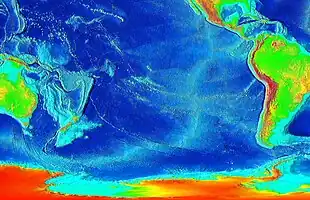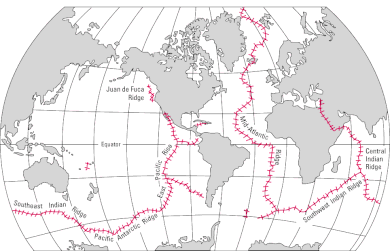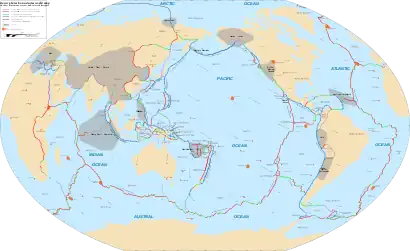Pacific-Antarctic Ridge
The Pacific-Antarctic Ridge (PAR) is a divergent tectonic plate boundary located on the seafloor of the South Pacific Ocean, separating the Pacific Plate from the Antarctic Plate. It is regarded as the southern section of the East Pacific Rise in some usages, generally south of the Challenger Fracture Zone and stretching to the Macquarie Triple Junction south of New Zealand.[1]

The Pacific-Antarctic Ridge is the southern extension of the East Pacific Rise.
The Louisville Ridge

The Louisville Ridge
Stretching for 4,300 km north-west from the Pacific-Antarctic Ridge to the Osbourn Seamount at Tonga and Kermadec Junction[2] is a long line of seamounts called the Louisville Ridge – the longest such chain in the Pacific[3] – thought to have formed from the Pacific Plate sliding over a long-lived center of upwelling magma called the Louisville hotspot.
References
- "Pacific-Antarctic Ridge". www.britannica.com. Retrieved 5 April 2013.
- Keating, Barbara H. (1987). Seamounts, Islands, and Atolls. American Geophysical Union. ISBN 0-87590-068-2.
- "Isotopic evidence for a hotspot origin of the Louisville Seamount Chain". www.agu.org. Retrieved 5 April 2013.
Further reading
- Cande, S. C.; Raymond, C. A.; Stock, J.; Haxby, W. F. (1995). "Geophysics of the Pitman Fracture Zone and Pacific-Antarctic plate motions during the Cenozoic". Science. 270 (5238): 947–953. Bibcode:1995Sci...270..947C. doi:10.1126/science.270.5238.947. S2CID 128877575.
This article is issued from Wikipedia. The text is licensed under Creative Commons - Attribution - Sharealike. Additional terms may apply for the media files.

